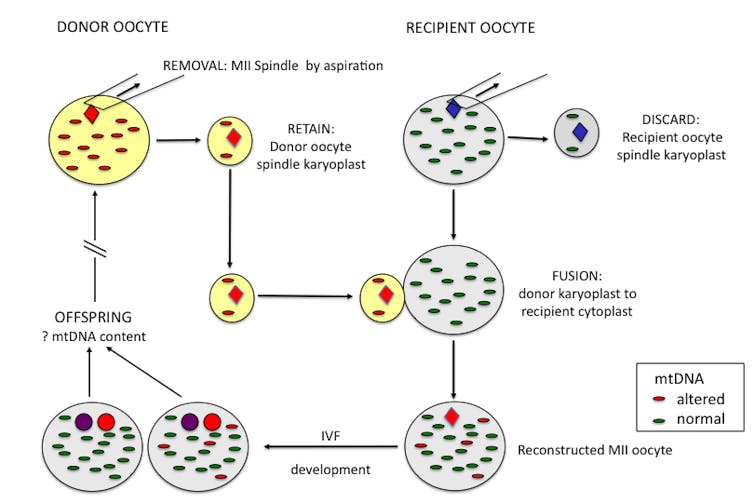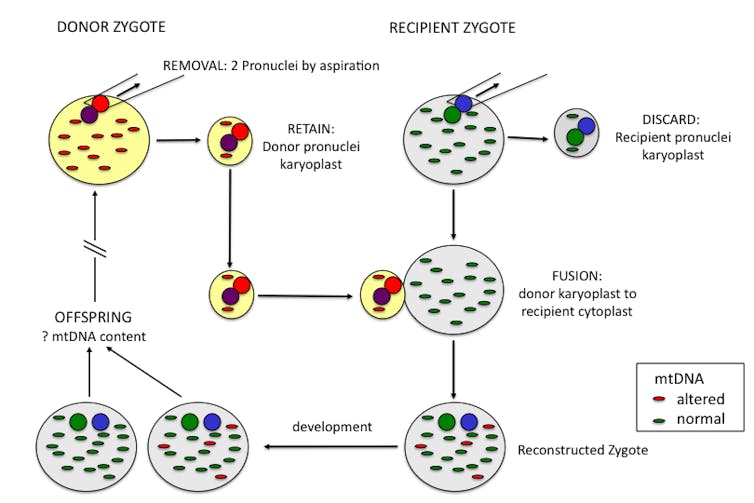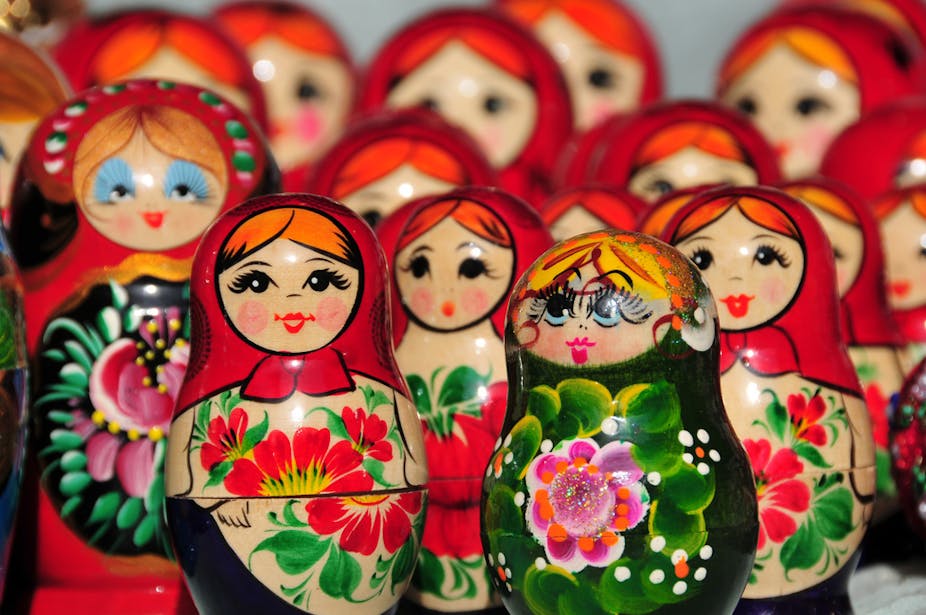Media outlets have been reporting that scientists are planning to “create designer babies” with three parents. Professor Justin St John, Director of the Centre for Reproduction and Development at Monash University explains the technology being proposed and its feasibility.
We inherit most genes from both parents, which determine things like hair colour, eye colour and behavioural patterns, but there’s a small proportion of DNA that we inherit only from our mothers. This DNA is from a region of the ovum (egg) called the cytoplasm, which houses organelles called mitochondria.
One of the main functions of mitochondria is to generate energy and that’s why they’re known as the powerhouses of the cell. Within each mitochondria, there’s a small round piece of DNA called the mitochondrial genome (mtDNA). This has some very important genes because they’re directly involved in the process of making energy. If any of these genes are mutated, then the individual will have severe disabilities related to not being able to generate enough energy or some of their cells will not function properly.
So we inherit our mtDNA only from our mother and what we inherit is the mtDNA that’s in her eggs just prior to fertilisation. Then our father’s sperm comes along and it delivers the chromosomal genes which join with our mother’s chromosomal genes and that’s the bulk of the DNA in the body.
The content of mtDNA gets changed during various stages of the development of the embryo and the foetus, while chromosomal DNA comes together and is then replicated or copied and will appear in each new cell. When the embryo starts to form all the different tissues of the body, the mutant mtDNA can go to some of the cells of the body – it can be distributed quite randomly.
So we can never predict if mutant mtDNA is going to distribute to cells which give rise to the brain, the heart, the kidneys or whatever. What happens is that if the mutant molecules go to cells that have a high requirement for energy, such as the brain or the muscle cells, then you’re likely to be hit by mitochondrial disease. If it distributes to tissues that are not necessarily high-energy requiring cells, then the likelihood of being affected is far less.
Currently, there are technologies that work with embryos, such as pre-implantation genetic diagnosis, which is used in IVF clinics. When an embryo forms, it starts by having two cells and then four, eight, sixteen onwards. This technology takes one of these cells and analyses it to see whether that embryo (and the child that it will form into), will be affected by the specific genetic disease.
And that’s perfectly fine for diseases associated with the chromosomal genome. But because we don’t understand how the mitochondrial genome distributes early on during development, the information that we get from pre-implantation genetic diagnosis doesn’t usually help in avoiding mitochondrial diseases.
The more appropriate process (since we know the mtDNA is in the woman’s egg) is to take out the genome from that egg and transfer it into an egg of a woman who isn’t a carrier of mitochondrial disease. Then you can fertilise this newly created or reconstructed egg with the father’s sperm. So the new baby will have chromosomes from it’s mother and father but it will have another population of mtDNA, which will be from the woman who donated her egg to this treatment. That’s why people will refer to children who would result from this process as having three parents.

And we don’t know whether these children will resemble the third parent. This technology is very similar to the way we do cloning and it’s interesting to consider some of the studies that have used cloning technology to, for instance, make different types of fish. Researchers took a cell from a carp and they transferred into a goldfish egg. The resulting fish did have some of the characteristics of the egg donor.
There’s another approach to circumventing mitochondrial disease. Instead of taking an unfertilised egg, you start with one that’s already been fertilised (zygote), so it’s got two populations of chromosomal DNA. You can go in and take out both these populations and transfer them into another zygote that has had these two bits removed.

The problem with these processes is that we’re not sure that when you perform these transfers, you’re not going to take a few of the mutant mtDNA with you. We know that mtDNA distributes or segregates unequally during early development and we don’t know if it’s being selected for or selected against – whether it persists or is eliminated. And we don’t know that if you carry over a few of these mtDNA with mutations, whether that will actually still lead to the onset of mitochondrial disease.
So we need some rigorous experiments to determine whether it’s possible to extract the chromosomes either from the mum’s egg or the newly fertilised egg, without taking any mutant mtDNA along.
Authors of some studies performed on monkeys in the United States have argued they didn’t carry mtDNA from the original egg when they performed this first process. But we suspect their detection processes weren’t rigorous enough, and they didn’t look at every tissue in the monkeys they created. Because mtDNA distributes unequally during early development, you’d have to check all the tissues to be sure there are no passed on mutations.
In Australia, the Heerey Committee sat last year to review whether we should keep certain technologies going for experimental purposes. Whether, for instance, we should still use cloning to try and make embryonic stem cells with human eggs and human embryos.
One of the matters the Committee discussed in their report was whether we could try to make embryos by transferring the mother’s and father’s chromosomes from one egg to another under experimental conditions. And our interpretation is that it might be allowable under license from the NHMRC but an application would have to be made that would be ruled on.
The other process of taking the chromosomes from an unfertilised egg wouldn’t be allowed because we’re talking about generating a new embryo for research purposes. That’s where the distinction between the two processes lies.
What we need to do is get a large body of data that’s based on sound experimental analyses together. Then scientists would be in a strong position to go to the government and show these technologies have been validated. And the government could make an informed decision about whether we can travel down this path to eradicating mitochondrial disease.
There are going to be groups that won’t want this to happen. It’s quite a controversial technology because we’re dealing with embryos; some people accept this but others find it abhorrent. Nevertheless, we have the opportunity to prevent the next generation of children from having mitochondrial disease.

